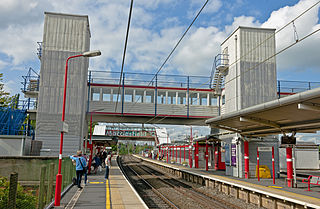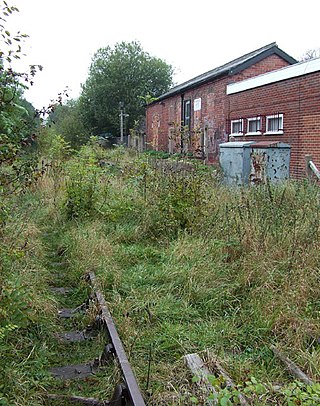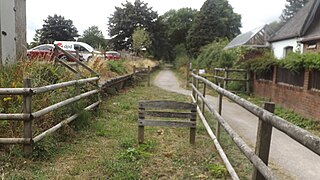
Biddulph is a town in Staffordshire, England, 8.5 miles (14 km) north of Stoke-on-Trent and 4.5 miles (7 km) south-east of Congleton, Cheshire.

The North Staffordshire Railway (NSR) was a British railway company formed in 1845 to promote a number of lines in the Staffordshire Potteries and surrounding areas in Staffordshire, Cheshire, Derbyshire and Shropshire.

Macclesfield railway station is a main line station serving the Cheshire town of Macclesfield. It lies on the Stafford to Manchester branch of the West Coast Main Line in the United Kingdom.

Congleton railway station is a mainline station serving the Cheshire town of Congleton. It lies on the Stafford-Manchester branch of the West Coast Main Line in the United Kingdom.

Uttoxeter railway station serves the town of Uttoxeter, Staffordshire, England. It is on the Crewe–Derby line, which is also a Community rail line known as the North Staffordshire line. The station is owned by Network Rail and managed by East Midlands Railway.

Leek Brook railway station is a passenger station in Staffordshire, Great Britain.
Mow Cop and Scholar Green railway station was a station on the North Staffordshire Railway between Stoke-on-Trent and Congleton. It served the village of Mow Cop.
The Churnet Valley line was one of the three original routes planned and built by the North Staffordshire Railway. Authorised in 1846, the line opened in 1849 and ran from North Rode in Cheshire to Uttoxeter in East Staffordshire. The line was closed in several stages between 1964 and 1988 but part of the central section passed into the hands of a preservation society and today operates as the Churnet Valley Railway.

Macclesfield Hibel Road railway station was a railway station serving the town of Macclesfield in Cheshire, England. It was opened as a joint station by the North Staffordshire Railway (NSR) and the London and North Western Railway (LNWR) on 13 July 1849, with the opening of the NSR route to Uttoxeter via North Rode and Leek and it replaced an earlier, temporary, LNWR station at Beech Bridge. Built right at the point where the track of the two companies made an end-on junction, the station was managed by a joint committee of the two companies.

Stockton Brook railway station is a disused railway station in Staffordshire.
The St Edward's Hospital tramway was a tramway built for Staffordshire County Council for the construction of the St Edward's County Mental Asylum at Cheddleton, Staffordshire. Opened in 1899, the line ran until 1954 before being closed and scrapped.
The Pinnox railway branch officially called the Spur line ran from Pinnox Junction to Tunstall Junction which was located just south of Tunstall railway station. The line was the lower of the two branch lines at Tunstall.

Higher Poynton was a railway station serving the eastern side of the town of Poynton in Cheshire, England. It was opened in 1869 by the Macclesfield, Bollington and Marple Railway (MB&M) - a joint line constructed and operated by the Manchester, Sheffield and Lincolnshire Railway (MS&L) and North Staffordshire Railways (NSR).

Endon railway station is a disused railway station in Staffordshire.

Black Bull railway station is a disused railway station in Staffordshire, England.

Ford Green & Smallthorne railway station is a disused railway station in Stoke-on-Trent, England.

The Biddulph Valley line was a double tracked line that ran from Stoke-on-Trent to Brunswick Wharf in Congleton. The line was named after the town of the same name as it ran via the Staffordshire Moorlands and covered areas of East Staffordshire and Cheshire.
The Longton, Adderley Green & Bucknall railway was a railway line in North Staffordshire that operated between 1875 and 1964. The line was the idea of the identically named Longton, Adderley Green & Bucknall railway company which was granted parliamentary approval in 1866 to build a 4.25 mi (6.84 km) goods only line from Botteslow Junction on the NSR's Biddulph Valley line. The L AG & B did not construct the line but leased all construction and operation to the NSR.
Congleton Upper Junction was a railway station which served the town of Congleton. The station was on the Stoke on Trent to Congleton loop line.
Mossley Halt was a railway station in Mossley, Congleton on the Biddulph Valley line. Mossley Halt was located about 1 and a half miles south of Congleton Railway Station.












